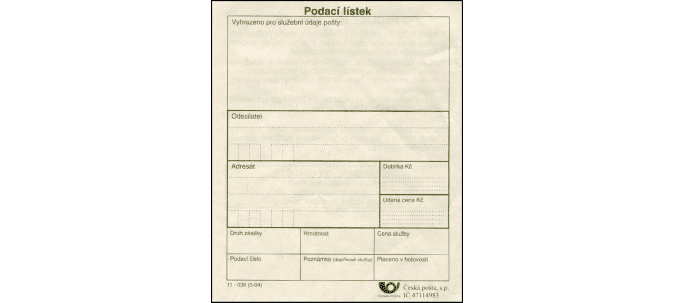A visit to a Czech office can seem intimidating, and many expats are put off by the experience. But post offices needn’t fill you with dread. Many have been modernised in the last few years, making them more user-friendly. And if you have access to online banking, you no longer need to go to the post office when paying bills. In this article, we‘ll look at some of the most common services offered at a Czech post office.
Certain postal services in the Czech Republic, such the issue of stamps, continue to be the sole responsibility of state-funded Czech Post (Česká pošta), signified by a logo with a blue horn against a yellow background. On the other hand, liberalization has allowed private firms such as DHL compete to with Czech Post for parcel delivery.
Generally, post offices are open between 08:00 and 18:00 on work days, although smaller POs observe a lunch break from 12:00 to 13:00. Most are usually open on Saturday mornings; some are open only from 08:00 to 10:00. On Sundays and public holidays, the majority are closed apart from a list largely made up of POs in regional capitals like České Budějovice. The main post office (PO) in Prague, at Jindřišská 14, is open from 02:00 until midnight seven days a week.
As with post offices everywhere, different counters provide different services. In large offices, such as the main PO in Prague, you’ll find a wide range of counters, and in such places a numbered ticketing system is in operation, with tickets issued according to the service you select. Smaller post offices have only 3 or 4 counters and therefore most services are handled at any of them.
Bear in mind that many postal staff only speak Czech, especially beyond the capital, although the likelihood of dealing with an English speaker is greater at the main PO in Prague. And as signs and information about services are in Czech only, it might be a good idea to ask a Czech-speaker to accompany you if you’re worried about language issues.
Here is a list of the most common services and terms.
Balík: parcel
Balíkové a listovní zasílky: Parcels and letters
Hromadné podání: bulk mail
Listovní služby: regular mail
Obálka: envelope
Peněžní služby: financial services
Příjem a vydaj balíků: parcels – send or pick-up
Stamps and letters
In the Czech Republic, addresses are written in the bottom right-hand corner; the name of the sender (odesílatel) should be written in the top left-hand corner. For mail within the Czech Republic, you should include the zip code or post code (směrovací číslo), a five-digit number that goes before the name of the city, town, or village. For mail within Prague, you should write the postal district after Praha, e.g. “150 00 Praha 5”. See the Czech Post website for a zip code finder.
When buying a stamp (známka, plural: známky) or posting a letter, you should go to any counter marked with the word “listovní“. Stamps can be bought individually or in bulk. See the Czech Post website for price details.
If you’re paying the postage charge at the post office, staff will automatically weigh the mail; obviously, the heavier the package, the more expensive the fee. Bear in mind that staff sometimes will often ask you if the mail is “obyčejný“, meaning non-registered delivery.
Parcels
To send a parcel, you should go to any counter marked “Zásilkové služby”, which is specifically for sending and receiving parcels. Other parcel services include Express Mail Service (EMS) for domestic express deliveries, and outsize parcel delivery.
Air mail
When sending mail abroad, your best option is Air Mail (Letecká pošta), also known as prioritní or Prioritaire, which is faster than surface mail, known as ekonomická. If you’re paying for the postage at the PO, the staff usually put a blue Prioritaire air mail sticker on the envelope or parcel anyway. Alternatively, simply write “Letecká pošta” on the envelope or parcel before handing it in.
Registered mail
You can also send registered (doporučená zasílka or doporučeně) letters or parcels within the Czech Republic or beyond. The maxium compensation for lost or damaged items is 500 CZK. Czech Post also offers an insured letter and insured parcel service for items with a value up to 1 million CZK.
Make sure you first fill out a submission form (podací lístek) so that the staff can proceed with your order.

It’s best to pick up a bunch of submission forms as you’re bound to use a fair amount. You’ll find them, along with other slips such as the složenka (see below), at counters and elsewhere in post offices. The key boxes to fill in are “Odesílatel” and “Adresát” (Addressee), although there is not much room for either. The addressee box doesn’t take into account the fact that the addressee may live outside the Czech Republic, and the question is how to write the address. The Adresát box only has 5 boxes for the post code, but zip codes in some countries, e.g. the UK, require more spaces. It shouldn’t cause any problems to simply add extra letters and/or numbers when necessary.
When registered mail arrives, the postal worker will ring your bell and ask you to sign for the mail. If you’re out, they will leave a Oznámení o uložení zásilky specifying (often in rather difficult to read handwriting) when and where you can pick up the letter or parcel. Check the pick up time, as you may have to wait a few hours before the letter is available.
Mail not picked up within the 15-day deadline will be returned to the post office, and you’ll then be sent another slip in the form of a computer printout, informing you that the mail is at the post office. Remember to take some form of recognised identification (such as a passport or residence permit) as you will be asked to sign for the mail.
Paying bills and receiving money
In the Czech Republic, a standard way to pay for services is the postal order (složenka or poštovní poukázka), which your electricity, gas, etc., company will send you every month. You can also fill in a blank postal order to make a payment, e.g. tax or social security contributions. Online banking users can pay bills using the details on the postal order; otherwise, you may need to use a postal order, in this case a Poštovní poukazka A – see picture below.

A. Boxes with částka and kč/h: the amount
B. V prospěch účtu: payee account number and bank code
C. Kód banky:Bank code identification number (ie. 0800 is Česká spořitelna)
D. Konstantní symbol:Identification (not always needed)
E. Variabilní: symbol: Variable symbol. Identification code – usually the number of an invoice
F. Specifický symbol:Specific symbol. A code relating to the type of payment (leave blank if not provided)
G. Adresa majitele účtu: The address of the payee
H. Účel platby: Literally purpose of account. You can just write ‘telephone bill´, ‘rent´ etc
I. Slovy:write out the amount in words
J. Č. Účtu/ Kód banky: bank account: payee bank account number.
If a company issues you with a postal order, most of the details on the slip will already be filled in; but in other cases, you will need to fill in everything yourself. The picture below shows you how to do so. If you are writing out a number with fewer digits than the number of boxes, you can fill in the blanks with zeros. The “Zpráva pro přijemce“ field can be left blank. The “Vyplní plátce…“ section at the bottom of the slip only applies to non-cash transactions made by those holding certain accounts with Poštovní spořitelna bank.
The stub on the left-hand side should be kept for your records, but don’t tear it off until the clerk has processed the postal order.
If you are receiving money, for example when the tax office owes you money and you opt to have it sent to you, you’ll receive a poštovní pouzkazka B. All the details will be filled in, and all you need to do is take ID and present the poukazka with ID at the PO.
Customs
In terms of customs regulations, different rules apply to items sent and received from EU and non-EU countries. Goods sent to or received from EU countries do not require customs clearance. For details of regulations applying to non-EU countries, see the Czech Post website.
For more detailed information on all of the above services refer to the English version of the Czech Post website
Related articles
- Czechia Is One of the Happiest Places On Earth Again this Year
- Prague Ranks Among Best Cities in the World for Millennials
- How Will the Latest Brexit News Affect British Expats in Czechia?
- Prague Named the Cheapest City in the World for Date Night
- Czech Republic Is Seventh Best Country In World For Expats












 Reading time: 7 minutes
Reading time: 7 minutes 




















